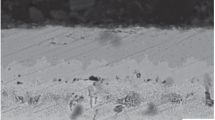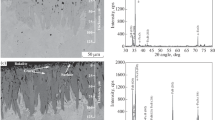Abstract
In this study, the effect of boronizing on the fatigue life of AISI 1040 steel was investigated. The boronizing process was carried out in the fluid bed furnace at temperatures 850 °C and 950 °C for 2, 4 and 6 hours. Boron layer thickness, micro structure, micro hardness and fatigue strength of the treated samples were investigated. The boronized layer on the surfaces became thicker by the increment of the process time and in addition micro hardness increased with the increment in process temperature and time. As a result of the fatigue tests conducted for comparison; shorter fatigue strength values were determined in boronized samples compared to cold drown AISI 1040 sample experiments. Samples which boronized at 950 °C for 6 hours had the lowest fatigue live under all experimental conditions and the highest fatigue cycle numbers were determined in non-boronized samples in fatigue tests.
Similar content being viewed by others
Abbreviations
- HV :
-
Vickers hardness
- FeB :
-
Ferro boron
- Fe 2 B :
-
Ferro di boron
- °C:
-
Celcius temperature scale
- Tb :
-
Boronizing temperature
References
V. Jain and G. Sundararajan, Influence of the pack thickness of the boronizing mixture on the boriding of steel, Surface and Coating Technology, 149(1) (2002) 21–26.
C. Meriç, S. Sahin, B. Backir and N. Koksal, Investigation of the boronizing effect on the abrasive wear behavior in cast irons, Materials & Design, 27(9) (2006) 751–757.
E. Atik, U. Yunker and C. Meriç, The effects of conventional heat treatment and boronizing on abrasive wear and corrosion of SAE 1010, SAE 1040, D2 and 304 steels, Tribology International, 36(3) (2003) 155–161.
W. Gräfen and B. Edenhofer, New developments in thermo-chemical diffusion processes, Surface and Coatings Technology, 200(5–6) (2005) 1830–1836.
C. Martini, G. Palombarini, G. Poli and D. Prandstraller, Sliding and abrasive wear behaviour of boride coatings, Wear, 256(6) (2004) 608–613.
A. K. Sinha, Boriding (Boronizing), ASM Handbook, Heat Treating, Materials Park, OH: ASM International, 4 (1991).
N. E. Maragoudakis, G. Stergioudis, H. Omar, E. Pavlidou and D. Tsipas, Boro-nitriding of steel US 37–1, Materials Letters, 57(4) (2002) 949–952.
Y. Kar, N. Șen and A. Demirbaș, Boron minerals in Turkey, their application areas and importance for the country’s economy, Minerals & Energy-Raw Materials Report, 20(3–4) (2006) 2–10.
H. B. Özerkan, Simultaneous machining and surface alloying of AISI 1040 steel by electrical discharge machining with boron oxide powders, Journal of Mechanical Science and Technology, 32(9) (2018) 4357–4364.
R. I. Stephens, A. Fatemi, R. R. Stephens and H. O. Fuchs, Metal Fatigue in Engineering, John Wiley & Sons (2000).
Y. Murakami, Metal Fatigue: Effects of Small Defects and Nonmetallic inclusions, Elsevier (2002).
A. Erdoǧan, Investigation of high temperature dry sliding behavior of borided H13 hot work tool steel with nanoboron powder, Surface and Coatings Technology, 357 (2019) 886–895.
K. F. Rodríguez-Galeano, R. Rodríguez-Baracaldo, A. Mestra-Rodríguez, J. M. Cabrera-Marrero and J. J. Olaya-Florez, Influence of boron content on the fracture toughness and fatigue crack propagation kinetics of bainitic steels, Theoretical and Applied Fracture Mechanics, 86 (2016) 351–360.
S. Golling, D. Frómeta, D. Casellas and P. Jonsén, Influence of microstructure on the fracture toughness of hot stamped boron steel, Materials Science and Engineering: A, 743 (2019) 529–539.
D.-J. Kong and C.-Y. Xie, Effect of laser quenching on fatigue properties and fracture morphologies of boronized layer on Cr12MoV steel, International Journal of Fatigue, 80 (2015) 391–396.
T. Savașkan, Malzeme Bilgisi ve Muayenesi, Derya Kitabevi. Trabzon, Turkey (1999).
A. S. Bora, Evaluation of mechanical behavior of borided low carbon full hard steel sheet, M.Sc. Thesis, İTÜ, Institute of Science and Technology, İstanbul (2017).
S. Yılmaz, B. Ünlü and R. Varol, Borlanmış ve bilyalı dövülmüş demir esaslı T/M malzemelerin aşınma ve mekanik özellikleri, Makine Teknolojileri Elektronik Dergisi, 1 (2008) 7–16.
W. Fichtl, N. Trausner and A. G. Matuschka, Boronizing with EKbor, Matuschka, A.G.; Boronizing, Heyden & Son Inc. Philadelphia (1980) 58–71.
U. Yapar, Improvement of surface properties of low and medium carbon steels by thermochemical bronizing, M.Sc. Thesis, İTÜ, Institute of Science and Technology, İstanbul (2003).
V. Jain and G. Sundararajan, Influence of the pack thickness of the boronizing mixture on the boriding of steel, Surface and Coatings Technology, 149(1) (2002) 21–26.
C.-W. Ji, I. Jo, H. Lee, I.-D. Choi, Y. Do Kim and Y.-D. Park, Effects of surface coating on weld growth of resistance spot-welded hot-stamped boron steels, Journal of Mechanical Science and Technology, 28(11) (2014) 4761–4769.
A. V. Reddy, Investigation of Aeronautical and Engineering Component Failures, CRC Press, 57 (2004).
Y. Kutucu, A. Oğur and Y. Kahraman, Borlanmış yüksek alaşımlı çeliklerde oluşan artık ısıl gerilmelerin sonlu elemanlar yöntemiyle belirlenmesi, Sakarya University Journal of Science, 18(3) (2014) 131–137.
Author information
Authors and Affiliations
Corresponding author
Additional information
Recommended by Associate Editor Seok-min Kim
Haci Bekir Özerkan received his Ph.D. degree in Mechanical Engineering from Gazi University. Since 2001, he has been working in Gazi University and his current position is the Lecturer at Gazi University Technical Vocational High School. His research interests include non-traditional machining and conventional machining methods.
Rights and permissions
About this article
Cite this article
Özerkan, H.B. Experimental fatigue life determination of thermo-diffusion surface boronized of AISI 1040 steel. J Mech Sci Technol 33, 4957–4962 (2019). https://doi.org/10.1007/s12206-019-0935-4
Received:
Revised:
Accepted:
Published:
Issue Date:
DOI: https://doi.org/10.1007/s12206-019-0935-4




